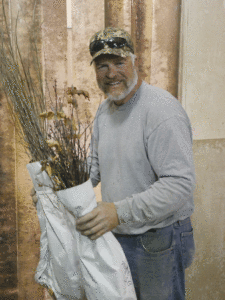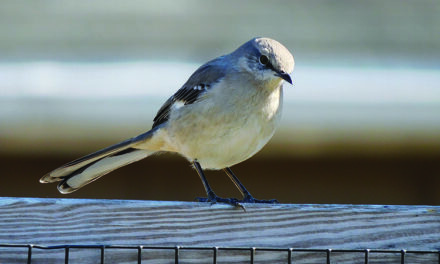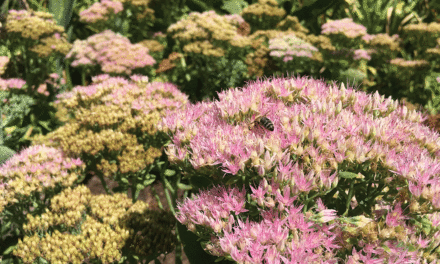
John S. Ayton State Tree Nursery manager Richard Garrett, holding a sapling bunch, said everything the nursery grows starts from seed. (Photos courtesy John S. Ayton State Tree Nursery)
Did you ever wonder how the world would look without trees?
Fred Besley, Maryland’s first state forester from 1906-42, witnessed first-hand how barren the public landscape looked after unhampered logging and agricultural practices of the late 1800s decimated once plentiful trees and became a champion of forest regeneration.
He wasn’t alone in his quest.
In 1914 the legislature passed the Roadside Tree Law, among the nation’s first directing a “state forestry department to plant, care for, and protect trees in the public right of way.”
The law effectively supported the establishment of a state tree nursery, dedicated to producing trees primarily for planting along highways and byways.
Having studied under Gifford Pinchot (regarded as the father of American forestry) Besley successfully created three state nurseries at the University of Maryland-College Park, known then as Maryland Agricultural College.
By 1950 the combined nursery moved to state forestland in Anne Arundel County and renamed Buckingham Tree Nursery. A tree improvement program producing upgraded specimens of loblolly and white pine began.
In 1996, Route 100 construction again prompted a move, this time to Caroline County, just outside Preston, again renamed the John S. Ayton Forest Nursery to honor the longtime supervisor who helped plan and design it.
Retiring in 1996, Ayton turned over the operational reigns to current manager Richard Garrett, with a new mandate to be self-sufficient.
Asked how long he’s been involved with the state tree nursery, Garrett replied “forever”, laughing heartily. As the surplus “third son” of a farmer, Garrett earned a forestry degree.
In 1984 he joined the state nursery, where he essentially became a tree farmer. At that time, he recalled, the hands-on work of planting and especially harvesting happened largely without machinery.
“We get no taxpayer funding,” Garrett said. Money to purchase the 300 acres in Preston was raised by selling the old nursery land. The budget is based solely on income generated through bulk sales of tiny trees, grown from seeds planted in the ground.
“Everything we do is from seed. Seed grows outside in the field. No greenhouses. Greenhouses require a lot of people. Much more intensive. Things happen faster in greenhouses, but bad things spread faster in greenhouses, too. We have three full-time people here, one contractual that works year round, four people in all. We have contract laborers, 12 to 14 people, who come in during harvest time,” Garrett explained.
After issuing a call for bids, the nursery purchases seed from suppliers and gathers it at numerous “manicured” sites, such as churches and schools (far more productive than woodland foraging, he explained. Landowners with surplus stashes of acorns and other seed also offer it to the nursery, a welcome practice they hope to see more of; however the seeds need to be of a single species rather than a mixture.
Small specialized mechanized harvesting machines — which Garret wishes he’d had during back-breaking seasons when he began — speed up and streamline the harvesting process. Other mechanized equipment aids efficiency during the assembly line packing operation and the delicate and painstaking task of cleaning harvested seeds. Due to its relatively small size compared with commercial nursery operations, some machines are too costly. In one case, with farmer/forester ingenuity, the staff improvised, discovering that a simple kitchen Cuisinart effectively separated seeds from chaff. Workers also may gently stomp bulk seed material by foot.
A cooling room set to 40 degrees F preserves harvested seedlings in a dormant state until they are shipped at variable times, depending on the tree species. Oaks, for instance, can safely remain dormant in the cooler for up to three months, while crabapples tend to awaken much more quickly, Garrett said. The nursery is now accepting orders, with shipping ongoing through May, depending on species and location throughout Maryland, Delaware, and other nearby areas.
The nursery’s 2020 seedling catalog offers close to 50 varied species of conifer and deciduous trees; over 3 million seedlings in all.
Hardwoods, the nursery’s biggest seller in recent years, can be “mixed and matched” in units of 25 per species; with smaller, more uniform conifers bundles in units of 50. Among these, loblolly pine, which used to be most in demand, has dropped off considerably from the timber industry’s heyday, Garrett added.
Though not as widely requested, the nursery strives to provide diverse varietals of native deciduous trees, including black cherry, silky dogwood, hazelnut, winterberry and many more. One distinct area of acreage features the “grandchildren” of the famed Wye Oak, Garrett noted.
The nursery provides several unique seedling packages specifically for organization fundraisers, including one for the Baltimore Zoo, and “Bay Bundles” of 5 to 10 trees offered by school horticulture programs.
Who are the nursery’s customers? Not people looking for already sizable trees, Garrett stated. “We don’t sell them. If you want a ball and burlap tree you can get it from a commercial center,” he explained. Other than that, “anybody and everybody. People with a big yard tired of mowing grass. People who want to put in a windbreaker on their property and those wanting privacy from neighbors. Anybody that harvests timber and wants to replant can get trees from us. Anybody that’s got 5 to 10 acres of farmland they don’t wish to work.
“We sell a lot to replenish land depleted from strip mining, and to folks that want to create wildlife habitat for critters and pollinators — butterflies and bees — turkey and deer, and everything in between. Some people just like songbirds and want trees that produce berries that attract them,” Garrett added.
To learn more, visit https://nursery.dnr.maryland.gov/





